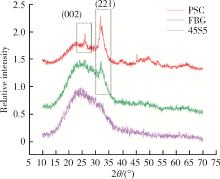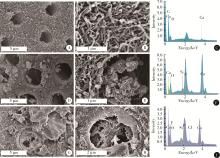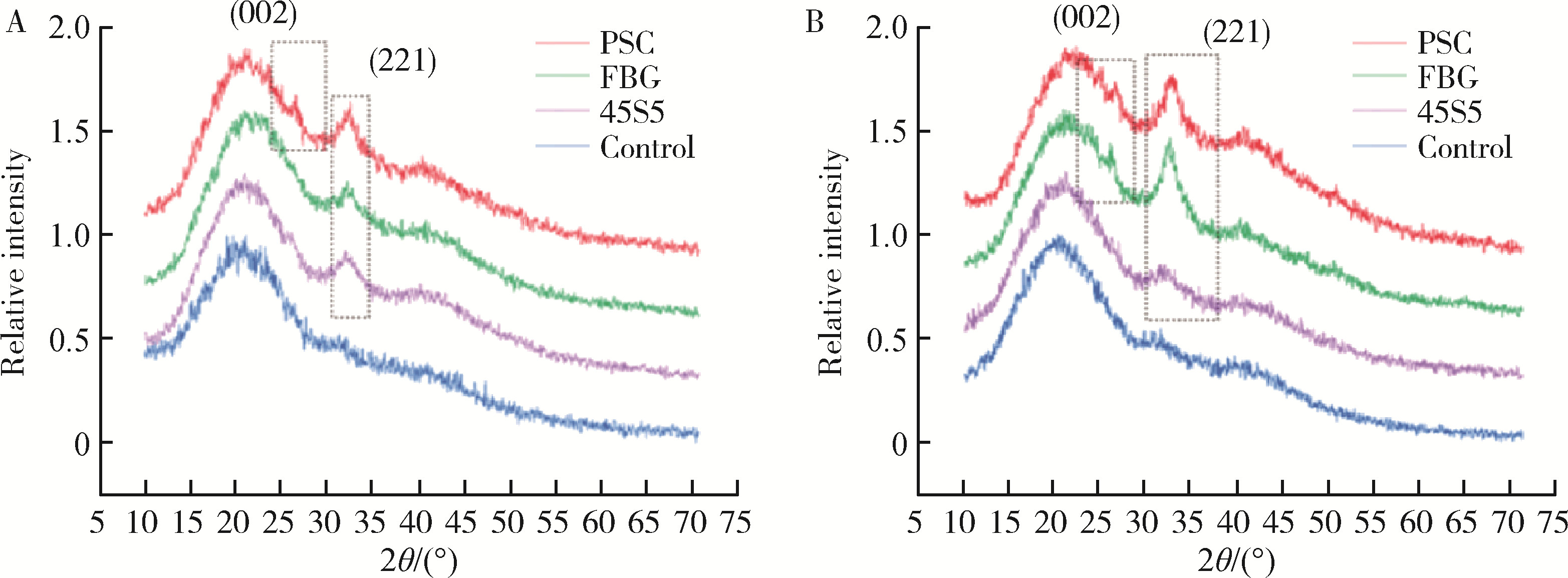Journal of Peking University (Health Sciences) ›› 2023, Vol. 55 ›› Issue (1): 82-87. doi: 10.19723/j.issn.1671-167X.2023.01.012
Previous Articles Next Articles
Effects of novel bioactive glasses on promoting remineralization of artificial dentin caries
Ruo-lan GUO,Gui-bin HUANG,Yun-zi LONG,Yan-mei DONG*( )
)
- Department of Cariology and Endodontology, Peking University School and Hospital of Stomatology & National Center of Stomatology & National Clinical Research Center for Oral Diseases & National Engineering Research Center of Oral Biomaterials and Digital Medical Devices & Beijing Key Laboratory of Digital Stomatology & NHC Research Center of Engineering and Technology for Computerized Dentistry & NMPA Key Laboratory for Dental Materials, Beijing 100081, China
CLC Number:
- R781.1
| 1 |
Han L , Okiji T , Okawa S . Morphological and chemical analysis of different precipitates on mineral trioxide aggregate immersed in different fluids[J]. Dent Mater J, 2010, 29 (5): 512- 517.
doi: 10.4012/dmj.2009-133 |
| 2 |
Tay FR , Pashley DH , Rueggeberg FA , et al. Calcium phosphate phase transformation produced by the interaction of the portland cement component of white mineral trioxide aggregate with a phosphate-containing fluid[J]. J Endod, 2007, 33 (11): 1347- 1351.
doi: 10.1016/j.joen.2007.07.008 |
| 3 | 黄贤圣, 李蓉, 冯云枝, 等. 生物活性玻璃NovaMin诱导脱矿牙本质再矿化[J]. 中南大学学报(医学版), 2018, 43 (6): 619- 624. |
| 4 |
Zhang Y , Wang Z , Jiang T , et al. Biomimetic regulation of dentine remineralization by amino acid in vitro[J]. Dent Mater, 2019, 35 (2): 298- 309.
doi: 10.1016/j.dental.2018.11.026 |
| 5 |
Sheng XY , Gong WY , Dong YM , et al. Mineral formation on dentin induced by nano-bioactive glass[J]. Chin Chem Lett, 2016, 27 (9): 1509- 1514.
doi: 10.1016/j.cclet.2016.03.030 |
| 6 |
Mneimne M , Hill RG , Brauer DS , et al. High phosphate content significantly increases apatite formation of fluoride-containing bioactive glasses[J]. Acta Biomater, 2011, 7 (4): 1827- 1834.
doi: 10.1016/j.actbio.2010.11.037 |
| 7 |
Lynch E , Brauer DS , Karpukhina N , et al. Multi-component bioactive glasses of varying fluoride content for treating dentin hypersensitivity[J]. Dent Mater, 2012, 28 (2): 168- 178.
doi: 10.1016/j.dental.2011.11.021 |
| 8 |
Shah FA . Fluoride-containing bioactive glasses: Glass design, structure, bioactivity, cellular interactions, and recent developments[J]. Mater Sci Eng C Mater Biol, 2016, 58, 1279- 1289.
doi: 10.1016/j.msec.2015.08.064 |
| 9 |
Li A , Qiu D . Phytic acid derived bioactive CaO-P2O5-SiO2 gel-glasses[J]. J Mater Sci Mater Med, 2011, 22 (12): 2685- 2691.
doi: 10.1007/s10856-011-4464-7 |
| 10 |
Chen X , Chen X , Pedone A , et al. New insight into mixing fluo-ride and chloride in bioactive silicate glasses[J]. Sci Rep, 2018, 8 (1): 1316.
doi: 10.1038/s41598-018-19544-2 |
| 11 |
Hench LL . The story of bioglass?[J]. J Mater Sci Mater Med, 2006, 17 (11): 967- 978.
doi: 10.1007/s10856-006-0432-z |
| 12 |
Pires PM , Santos TP , Fonseca GA , et al. A dual energy micro-CT methodology for visualization and quantification of biofilm formation and dentin demineralization[J]. Arch Oral Biol, 2018, 85, 10- 15.
doi: 10.1016/j.archoralbio.2017.09.034 |
| 13 |
Neves AD , Coutinho E , Cardoso MV , et al. Micro-CT based quantitative evaluation of caries excavation[J]. Dent Mater, 2010, 26 (6): 579- 588.
doi: 10.1016/j.dental.2010.01.012 |
| 14 |
Lo EC , Zhi QH , Itthagarun A . Comparing two quantitative me-thods for studying remineralization of artificial caries[J]. J Dent, 2010, 38 (4): 352- 359.
doi: 10.1016/j.jdent.2010.01.001 |
| 15 | Olejniczak AJ , Grine FE . Assessment of the accuracy of dental enamel thickness measurements using microfocal X-ray tomography[J]. Anat Rec A Discov Mol Cell Evol Biol, 2006, 288 (3): 263- 275. |
| 16 |
Pires PM , Santos TP , Fonseca-Gonalves A , et al. Mineral density in carious dentine after treatment with calcium silicates and polyacrylic acid based cements[J]. Int Endod J, 2018, 51 (11): 1292- 1300.
doi: 10.1111/iej.12941 |
| 17 | Carvalho RN , Letieri ADS , Vieira TI , et al. Accuracy of visual and image-based ICDAS criteria compared with a micro-CT gold standard for caries detection on occlusal surfaces[J]. Braz Oral Res, 2018, 32, e60. |
| 18 | Jones JR . Reprint of: Review of bioactive glass: From Hench to hybrids[J]. Acta Biomater, 2015, (Suppl 23): 53- 82. |
| 19 |
Cui CY , Wang SN , Ren HH , et al. Regeneration of dental-pulp complex-like tissue using phytic acid derived bioactive glasses[J]. RSC Adv, 2017, 7 (36): 22063- 22070.
doi: 10.1039/C7RA01480E |
| 20 | Ren HH , Tian Y , Li AL , et al. The influence of phosphorus precursor on the structure and properties of SiO2-P2O5-CaO bioactive glass[J]. Biomed Phys Engi Express, 2017, 3 (4): 1- 8. |
| 21 | Li A , Wang D , Xiang J , et al. Insights into new calcium phosphosilicate xerogels using an advanced characterization methodology[J]. J Non Cryst Solids, 2011, 357 (19/20): 3548- 3555. |
| [1] | HUANG Li-dong,GONG Wei-yu,DONG Yan-mei. Effects of bioactive glass on proliferation, differentiation and angiogenesis of human umbilical vein endothelial cells [J]. Journal of Peking University (Health Sciences), 2021, 53(2): 371-377. |
| [2] | Qiu-ju LI,Wei-yu GONG,Yan-mei DONG. Effect of bioactive glass pretreatment on the durability of dentin bonding interface [J]. Journal of Peking University (Health Sciences), 2020, 52(5): 931-937. |
| [3] | LONG Yun-zi,LIU Si-yi, LI Wen, DONG Yan-mei. Physical and chemical properties of pulp capping materials based on bioactive glass [J]. Journal of Peking University(Health Sciences), 2018, 50(5): 887-891. |
| [4] | ZHU Lin, WANG Yu-dong, DONG Yan-mei,CHEN Xiao-feng. Mesoporous nano-bioactive glass microspheres as a drug delivery system of mino-cycline [J]. Journal of Peking University(Health Sciences), 2018, 50(2): 249-255. |
| [5] | GONG Wei-yu, LIU Shao-qing, DONG Yan-mei, GAO Xue-jun, CHEN Xiao-feng. Nano-sized bioactive glass enhances osteogenesis of critical bone defect in rabbits#br# [J]. Journal of Peking University(Health Sciences), 2018, 50(1): 42-48. |
| [6] | LI Hao, LIU Yu-hua, LUO Zhi-qiang. Effects of bioactive glass on reducing the hypersensitivity after full crown preparation [J]. Journal of Peking University(Health Sciences), 2017, 49(4): 709-713. |
| [7] | XIN Yi, WANG Sai-nan, CUI Cai-yun, DONG Yan-mei. Effects of bioactive glass and extracted dentin proteins on human dental pulp cells [J]. Journal of Peking University(Health Sciences), 2017, 49(2): 331-336. |
| [8] | LIU Yi, WANG Sai-nan, CUI Cai-yun, DONG Yan-mei. Influence of the Arg-Gly-Asp-Ser sequence on the biological effects of bioactive glass on human dental pulp cells [J]. Journal of Peking University(Health Sciences), 2017, 49(2): 326-330. |
| [9] | HU Jia,ZOU Xiao-ying,ZHUANG Heng,GAO Xue-jun. Effect of root canal sealers on biocompatibility of human periodontal ligament cells [J]. Journal of Peking University(Health Sciences), 2016, 48(5): 871-877. |
| [10] | QIAO Di, DONG Yan-mei, GAO Xue-jun. In vitro study of biological characteristics of new retrograde filling materials iRoot [J]. Journal of Peking University(Health Sciences), 2016, 48(2): 324-329. |
|
||





